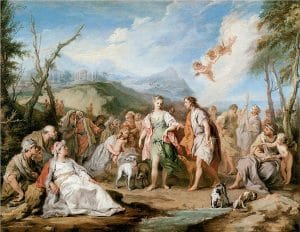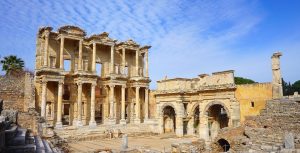Beauty style of women in daily life in Ephesus
In ancient Ephesus, women’s beauty and care had a very important place in their lives. She had her style and women he followed as role models. The same behavior we follow as a tabloid today was also valid in ancient Ephesus. For example, a woman was trying to follow how her friends, who are opposite neighbors, did their hair, how they made their skin whiter, how they removed their hair, and what essences and perfumes would be.
While the concept of beauty in Ancient Ephesus had perhaps more limited possibilities, they were trying to maximize these limited possibilities. This is indeed an act of admiration for our time. But more interestingly, the ancient Ephesus also uses women’s labor for their beauty and the products they used in women of our time. The only difference is that place, location and time are older.
Beauty in women of ephesus
Magnificent Beauty
Let’s look at the goddesses worshiped by the Ephesians in ancient Ephesus, for example, Aphrodite was the goddess of beauty in ancient Greece. We can see the concept of beauty that should be in women in mythologies and sculptures written in ancient times. They depicted the goddesses with full-body features, graceful faces, long wavy hair, and fair skin. Elegance and perfect lines were very important virtues for women living in ancient times.

In addition, these appearance features of the goddesses were seen as a symbol of wealth for the Ephesian women living in ancient times. Some women even used chalk and poisonous lead to make their skin and complexion appear lighter. They risked their health for their beauty. So why did the women of Ephesus want to be seen with white skin? The answer to this question meant that white-skinned women saw less sun. So what did that mean? In wealthy societies, wealthy women’s skin color was usually white.
The meaning white skin color represented the woman who stayed at home and looked after her children. The darker skin color meant that these women worked outside and were probably slaves.
For example, let’s look at another important female character of the ancient world, Helen, one of the most important women of ancient Greece. In Greek mythology, Helen is known as the most beautiful woman in the world who caused the Trojan War. According to mythological legends, she is the only daughter of Zeus from a mortal woman.
Afterward, Helen flew to Troy with Paris, and because of Helen, there was a Trojan war between the ancient Greeks and the Trojans, which caused great suffering. Trojan warriors and Greek warriors fought for Helen for 10 years. According to the myths and statue descriptions, Helen had red hair. Redheads were seen as a symbol of beauty in ancient Ephesus.
Sacrifices made by women in Ephesus for beauty
The women of ancient Ephesus used unusual methods to make their skin color appear white. Some of these methods were both dangerous and deadly. The make-up for women in ancient times to make their skin look white was first written and described by the Greek philosopher Theophrastus.
He explained the production and process of carbonate lead, known as Ceruse (Lead white) used by the women of Ephesus. This product and make-up model was a method used by women from Ephesus to make their skin artificially white. But what the women of Ephesus didn’t know was that the method they used was also extremely poisonous.
Statuses and make-up styles in Ephesian Women
In the ancient world, make-up was the greatest power to enhance one’s beauty. Especially in Ancient Ephesus, women of wealthy families fought fiercely to look beautiful. The women of Ephesus always tried to develop different methods to show their beauty in the best way. In addition, in ancient Ephesus, women were known for the way they wore makeup. For example, rich women, normal women, slave women, prostitutes, and hetairas we call noble sex workers wore different make-ups.
But the most assertive among them were the hetairas. Because their dress was very provocative, and the make-up they did was very complimentary.
The corners of these women’s eyes were covered with exaggerated charcoal, and their lips were painted brightly. The prestigious women of the socialite in ancient Ephesus preferred simpler make-up. Also, because the Hetaires lost their hair, they were immediately recognizable by their different clothes in different colors.

The Hairstyles Of Ancient Ephesus Women

In the earliest depictions of women in Ancient Ephesus, it was seen that the women of Ephesus had their hair braided with many types of fine braids. This hairstyle was primarily adopted in the archaic period. Afterward, it is seen in sculptures, busts, and paintings of women from ancient Ephesus.
However, when the lifestyles in ancient Ephesus began to change, the hairstyles of the women of Ephesus also changed. The women of Ephesus generally had long hair, but around the 5th century BC, they began to use bun shapes. Their hairstyles were quite ornate, and they began to decorate their hair with jewelry.
Ephesian women’s hair was cut short if a family member died. In this way, the Ephesians knew that the short-haired Ephesian woman was in pain. Also, short hair was a sign of lower status in ancient Ephesus.
In addition, another feature that women paid attention to in ancient Ephesus is that women wanted to lighten their hair color. The women of Ephesus used vinegar and lemon juice products to lighten their hair colors. Afterward, they used chamomile water to lighten their hair colors.
In addition, the women of Ephesus tried very hard to have their hair wavy. They were curling their hair for this. The women of Ephesus placed wax between their hair to make their hair last longer. The hair thing in the women of Ephesus was a struggle in itself.
Epilation in women of Ephesus
Epilation was not an easy practice in ancient times. But the epilation methods used by women to clinch their beauties date back to ancient times. In ancient Ephesus, it was certainly fashionable for Ephesian women to have no body hair. In addition, the women of Ephesus could not tolerate body hair. We learn the epilation methods of Ephesians in ancient times from inscriptions and pictorial descriptions.
The most common epilation methods of the women of Ephesus were burning the pubic area with a flame or plucking or shaving with a cutting knife or razor. According to the conditions of the ancient period, epilation was a very difficult and dangerous method.
Beauty concept for the woman from Ephesus
If we use herbal or animal products for beauty materials today, the biggest reason for this is the products used by women in ancient times and ancient Ephesus. Not much has changed since then. Of course, the variety of products has increased, but all of the products used as beauty products are products that women have tried and succeeded in the ancient period.
In our current time, we can see these products on our vanity tables or in our bathrooms. But in the Ancient Ephesus period, these products were difficult to reach for the women of Ephesus and they paid a lot of money with limited opportunities.
Olive oil for the woman of Ephesus
The most famous cosmetic tool of the ancient Ephesus period was olive oil. In ancient times, olive oil was used both in the kitchens of ancient Ephesian women and as a beauty and cosmetic product.
Especially the moisturizing texture of olive oil would be very good for dry skin.
In this way, the women of Ephesus were able to keep their skin soft and supple.
In addition, they used to mix and use herbs to give their olive oil a good smell.
In addition, the women of Ephesus used olive oil as a care treatment for their hair.
But let’s not forget that olive oil was one of the most expensive products of the Ancient Ephesus period.

The symbol of Ephesus for the women of Ephesus
The biggest feature of honey is that it is antibacterial and this was known in the ancient world and also in ancient Ephesus. It should not be forgotten that the symbol of the ancient city of Ephesus is the BEE. The Ephesians were very confident in the power of the bee and its healing effect of the bee. In the ancient Ephesus period, bee products were used both medicinally and as beauty and make-up materials. In ancient times, bee products were very valuable, especially by the Ephesians. They had great respect for bees and bee products.
Beeswax of the ancient city of Ephesus
Beeswax was also used medicinally in ancient times and the ancient city of Ephesus. Hippocrates, known as the father of medicine in ancient Greece, also used beeswax as a medicinal drug. Also, one of the famous doctors of the time, Galenos of Pergamon, created a cream that was one of the first known cosmetic products. This cream consisted of beeswax, olive oil, and rose water and was indispensable for the wealthy women of Ephesus.
The importance of ancient perfumes for women of Ephesus
Fragrant perfumes were an invariable part of beauty for Ancient Ephesus and its women. A woman from Ephesus used to apply scented oils to her body after taking a bath. These oils also had perfume properties. In ancient times, they made both essential oils and perfumes by mixing fragrant flowers with oils.
The heads of fragrant flowers were put into the oil and synthesized. It was then filtered through the cloth, leaving a fragrant perfume. This is how the first perfumes of the ancient world were produced.
Charcoal is used in beauty

Ephesian women living in ancient Ephesus were developing various methods to increase their beauty.
One of them was charcoal.
So how did they use this charcoal for their beauty?
First of all, charcoal was natural and did not need to be mixed with any other substance.
Women used charcoal to darken the color of their eyelashes and make their eyes more defined by drawing them.
They also used charcoal on their eyelids to highlight their eyes.
They would also mix charcoal with other powdered minerals to obtain various colors and apply them to their bodies.
Eyebrows of Ephesian women in Ancient Ephesus
Eyebrow shapes and eyebrow thicknesses have varied a lot since ancient times. Since then, there have been bushy eyebrows, thick eyebrows, and thin eyebrow variability. But the eyebrows of the women living in ancient Ephesus were single. In ancient Ephesus, one eyebrow was considered a symbol of both beauty and intelligence. Ephesian women painted the spaces between their eyebrows to give the appearance of a single big eyebrow.
If the painting was not effective, then the women of Ephesus would glue animal hairs to tree resins and stick those resins in the gap between their eyebrows. It was a difficult but effective method. The women of Ephesus gave great importance to their beauty, for themselves, their families, and their men.





